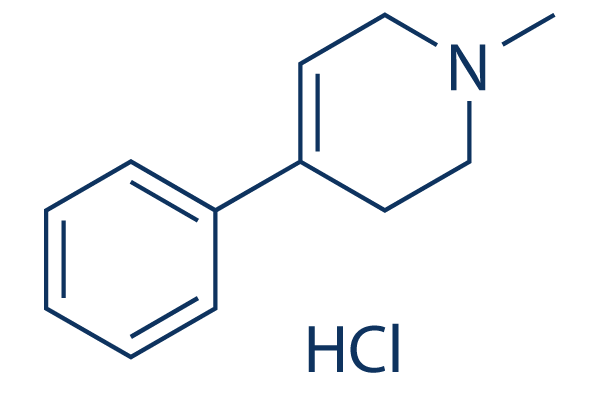|
受注:045-509-1970 |
技術サポート:[email protected] 平日9:00〜18:00 1営業日以内にご連絡を差し上げます |
化学情報

|
Synonyms | N/A | Storage (From the date of receipt) |
3 years -20°C powder 1 years -80°C in solvent |
| 化学式 | C12H15N·HCl |
|||
| 分子量 | 209.72 | CAS No. | 23007-85-4 | |
| Solubility (25°C)* | 体外 | Water | 41 mg/mL (195.49 mM) | |
| Ethanol | 41 mg/mL (195.49 mM) | |||
| DMSO | 26 mg/mL (123.97 mM) | |||
|
* <1 mg/ml means slightly soluble or insoluble. * Please note that Selleck tests the solubility of all compounds in-house, and the actual solubility may differ slightly from published values. This is normal and is due to slight batch-to-batch variations. |
||||
溶剤液(一定の濃度)を調合する
生物活性
| 製品説明 | MPTP hydrochloride is a dopaminergic neurotoxin and cause selective destruction of dopaminergic neurons in animal models of parkinsonism. MPTP hydrochloride induces apoptosis. |
|---|---|
| in vitro | The morphology of N2AB-1 and glioma cells was unaltered when these cells were exposed to all doses of MPTP. And, C6 glioma cell proliferation was also unaffected by MPTP treatment[3]. MPTP Promotes Apoptosis and Tau Phosphorylation in Human Neuroblastoma M17 Cells. MPTP significantly promotes Tau phosphorylation at Ser262 in human neuroblastoma M17 cells. MPTP caused a dose-dependent increase in the intracellular α-synuclein level in our M17 human neuroblastoma cells. MPTP appears to promote Tau phosphorylation in the brain by activating both PKA and GSK3β[4]. |
| in vivo | The number of tyrosine hydroxylase-positive neurons was decreased in the substantia nigra pars compacta of MPTP-treated mice. MPTP decreased thioredoxin reductase 1 expression and thioredoxin reductase activity in the mouse midbrain, reduced the number of thioredoxin reductase 1-positive cells in the substantia nigra pars compacta of mice. Administration of the toxin MPTP can cause neurochemical, behavioral and histopathological alterations in human and nonhuman primates that are similar to those observed in Parkinsonian patients. Compared with primates, rodents are insensitive to MPTP. MPTP can be administered by various routes, such as gavage and stereotactic injection, but the most common and reproducible route is systemic administration, including subcutaneous, intravenous, intraperitoneal and intramuscular injection. MPTP is a lipophilic protoxin that can rapidly cross the blood-brain barrier following systemic injection. Once it enters the brain, MPTP is converted to 1-methyl-4-phenylpyridine by monoamine oxidase B[1]. MPTP has been shown to be toxic to dopaminergic neurons of the nigrostriatal system in humans, monkeys, and mice and to produce long-lasting depletion of DA and its metabolites in the striatum[2]. |
プロトコル(参考用のみ)
| 細胞アッセイ | 細胞株 | N2AB-1 neural cell line and the C6 glioma cell line |
|---|---|---|
| 濃度 | 47.7, 4.77 and 0.477 μM | |
| 反応時間 | 1, 2, 3 days | |
| 実験の流れ | N2AB-1 and C6 glioma cells were plated in 24-well costar dishes (16 mm diameter) at 50,000 cells per well with the culture medium described above. After 24 h medium was removed and medium with varying concentrations of MPTP or MPP+ was added in duplicate. Control and treated cells were then trypsinized and counted with a hemocytometer every day for 3 days following treatment. |
|
| 動物実験 | 動物モデル | C57BL/6 mice |
| 投薬量 | 20 mg/kg | |
| 投与方法 | i.p. |
参考
Selleckの高級品が、幾つかの出版された研究調査結果(以下を含む)で使われた:
| Echinacoside exerts neuroprotection via suppressing microglial α-synuclein/TLR2/NF-κB/NLRP3 axis in parkinsonian models [ Phytomedicine, 2024, 123:155230] | PubMed: 38000105 |
| Phosphorylated α-synuclein deposited in Schwann cells interacting with TLR2 mediates cell damage and induces Parkinson's disease autonomic dysfunction [ Cell Death Discov, 2024, 10(1):52] | PubMed: 38278799 |
| NOX4 as a critical effector mediating neuroinflammatory cytokines, myeloperoxidase and osteopontin, specifically in astrocytes in the hippocampus in Parkinson's disease [ Redox Biol, 2023, 62:102698] | PubMed: 37058998 |
| Fucoidan from Fucus vesiculosus prevents the loss of dopaminergic neurons by alleviating mitochondrial dysfunction through targeting ATP5F1a [ Carbohydr Polym, 2023, 303:120470] | PubMed: 36657849 |
| Leucine-rich repeat kinase 2 (LRRK2) inhibition upregulates microtubule-associated protein 1B to ameliorate lysosomal dysfunction and parkinsonism [ MedComm (2020), 2023, 4(6):e429] | PubMed: 38020716 |
| Targeting CB2R in astrocytes for Parkinson's disease therapy: unraveling the Foxg1-mediated neuroprotective mechanism through autophagy-mediated NLRP3 degradation [ J Neuroinflammation, 2023, 20(1):304] | PubMed: 38110963 |
| Reduction of fetuin-A levels contributes to impairment of Purkinje cells in cerebella of patients with Parkinson's disease [ BMB Rep, 2023, 56(5):308-313] | PubMed: 36935573 |
| Deacetylation of ZKSCAN3 by SIRT1 induces autophagy and protects SN4741 cells against MPP+-induced oxidative stress [ Free Radic Biol Med, 2022, 181:82-97] | PubMed: 35124181 |
| Single-cell RNA sequencing of CSF reveals neuroprotective RAC1+ NK cells in Parkinson's disease [ Front Immunol, 2022, 13:992505] | PubMed: 36211372 |
| Echinacoside Protects Dopaminergic Neurons Through Regulating IL-6/JAK2/STAT3 Pathway in Parkinson's Disease Model [ Front Pharmacol, 2022, 13:848813] | PubMed: 35281889 |
長期の保管のために-20°Cの下で製品を保ってください。
人間や獣医の診断であるか治療的な使用のためにでない。
各々の製品のための特定の保管と取扱い情報は、製品データシートの上で示されます。大部分のSelleck製品は、推薦された状況の下で安定です。製品は、推薦された保管温度と異なる温度で、時々出荷されます。長期の保管のために必要とされてそれと異なる温度で、多くの製品は、短期もので安定です。品質を維持するが、夜通しの積荷のために最も経済的な貯蔵状況を用いてあなたの送料を保存する状況の下に、製品が出荷されることを、我々は確実とします。製品の受領と同時に、製品データシートの上で貯蔵推薦に従ってください。
